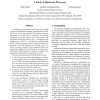Free Online Productivity Tools
i2Speak
i2Symbol
i2OCR
iTex2Img
iWeb2Print
iWeb2Shot
i2Type
iPdf2Split
iPdf2Merge
i2Bopomofo
i2Arabic
i2Style
i2Image
i2PDF
iLatex2Rtf
Sci2ools
MICRO
2000
IEEE
2000
IEEE
A study of slipstream processors
A slipstream processor reduces the length of a running program by dynamically skipping computation non-essential for correct forward progress. The shortened program runs faster as a result, but it is speculative. So a second, unreduced copy of the program is run concurrently with and slightly behind the reduced copy — leveraging a chip multiprocessor (CMP) or simultaneous multithreading (SMT). The short program passes its control and data flow outcomes to the full program for checking. And as it checks the short program, the full program fetches and executes more efficiently due to having an accurate picture of the future. Both programs are sped up: combined, they outperform conventional non-redundant execution. We study slipstreaming with the following key results.
Related Content
| Added | 01 Aug 2010 |
| Updated | 01 Aug 2010 |
| Type | Conference |
| Year | 2000 |
| Where | MICRO |
| Authors | Zachary Purser, Karthik Sundaramoorthy, Eric Rotenberg |
Comments (0)

